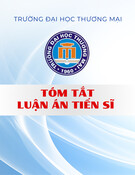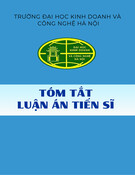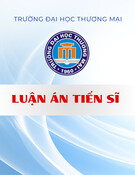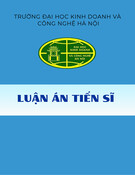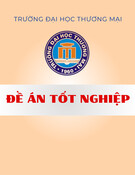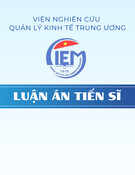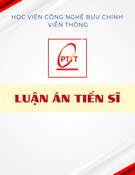
2
+ Giới hạn thời gian: Giai đoạn 5 năm từ 2013 – 2017.
4. Mô hình và phƣơng pháp nghiên cứu
Mô hình nghiên cứu:
Nghiên cứu này sử dụng mô hình Nghiên cứu mô tả. Với ưu
điểm chính của nghiên cứu mô tả là nó sử dụng dữ liệu định tính và
định lượng để phân tích, đo lường, giúp mô tả và đánh giá mối quan
hệ tác động của một hoặc nhiều biến độc lập đến biến phụ thuộc
được chọn. Từ đó đưa ra giải đáp cho các mục đích nghiên cứu và
hàm ý chính sách.
* Phƣơng pháp ƣớc lƣợng định tính:
Phương pháp định tính được sử dụng để lựa chọn các biến trong
nghiên cứu. Biến phụ thuộc đƣợc chọn là hiệu quả hoạt động của
doanh nghiệp, thông qua các chỉ tiêu tài chính là tỷ suất lợi nhuận
sau thuế trên tài sản (ROA), tỷ suất lợi nhuận trên vốn chủ sở hữu
ROE; Các biến độc lập đƣợc chọn là tính thanh khoản thông qua
các chỉ số là tỷ lệ nắm giữ tiền mặt (CASH), tỷ lệ thanh toán hiện
hành (CR - Current ratio), tỷ lệ khả năng dòng tiền thanh toán
(OCFR - Operating Cash Flow Ratio).
* Phƣơng pháp nghiên cứu định lƣợng:
Nghiên cứu định lượng được sử dụng là phương pháp hồi quy
tuyến tính bội đa biến giữa biến phụ thuộc và các biến độc lập được
chọn theo ước lượng phương sai bình phương nhỏ nhất. Các mô hình
hồi quy OLS, mô hình tác động cố định FEM (Fixed Effect Model),
mô hình tác động ngẫu nhiên REM (Random Effect Model). Sử dụng
phần mềm Eviews để tiến hành phân tích định lượng, kiểm tra lựa
chọn mô hình phù hợp, kiểm định và khắc phục khuyết tật của mô
hình và tiến hành hồi quy. Dữ liệu dạng bảng (panel data) được thiết
lập để áp dụng. Tiến hành phân tích, đo lường, đánh giá, mô tả xem






